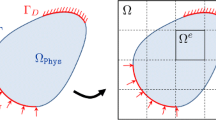Abstract
A Cartesian shrink wrapping technique has been investigated in this study to construct triangular surface meshes for three-dimensional dirty geometries. The geometries dealt in this paper are defined by faceted representation with dirtiness such as nonconforming edges, gaps and overlaps. The objective of the proposed technique is to deliver a way constructing triangular surface meshes for upstream solutions in design processes without extensive labors for healing dirtiness in complicated dirty geometries. A Cartesian grid is overlaid onto the dirty geometries and its cells are adaptively refined until target resolution is achieved while recording intersections with geometric facets in cells. An initial watertight shell called the wrapper surface is constructed by selectively extracting the boundary sides of intersected cells. The wrapper surface is improved by a subsequence of operations such as projecting nodes onto geometry, adjusting nodes on the geometry and editing local triangular faces to achieve better approximation. The meshes generated using the presented technique may not be geometrically accurate but their quality is good enough to quickly deliver upstream fluid analysis solutions with significantly reduced engineering time for problems of extreme complexity such as the full underhood fluid/thermal analysis for automobiles. Mesh generation experiments have been carried out for complicated geometries and results from some applications are presented in this paper.
Access this chapter
Tax calculation will be finalised at checkout
Purchases are for personal use only
Preview
Unable to display preview. Download preview PDF.
Similar content being viewed by others
References
M. J. Aftosmis, M. J. Berger and J. E. Melton (1997) Robust and efficient Cartesian mesh generation for component-based geometry, AIAA Paper 97–0196
S. Bischoff, D. Pavic and L. Kobbelt (2005) Automatic restoration of polygo-nal models, ACM Trans. Graphics, 24(4), pp. 1332–1352.
M. W. Beall, J. Walsh and Mark S. Shephard (2003) Accessing CAD geometry for mesh generation. Proc. 12th International Meshing Roundtable, pp. 33–42
CD-Adapco (2006) PROSTAR Automatic Meshing, http://www.adapco.com/ SoftwareProducts/ proam-htm.htm
CEI Ensight (2006) Harpoon: The Extreme Mesher, http://www.ensight.com/ products/harpoon.html
CFDRC, CFD-VisCART, http://www.cfdrc.com/serv_prod/cfd_multiphysics/ software/ace/viscart.html
M. Garland and P. S. Heckbert (1997) Surface simplification using quadric error metrics, Proc. 24th Annual Conf. on Computer Graphics and Interactive Techniques, pp. 209–216
L. R. Hermann (1976) Laplacian-Isoparametric Grid Generation Scheme, J. of the Engineering Mechanics Division of the American Society of Civil Engineers, 102, pp. 749–756
L. Kobbelt, J. Vorsatz, U. Labsik and H.P. Seidel (1999) A shring wrapping approach to remeshing polygonal surfaces, Computer Graphics Forum, 18(3), pp. 119–130
M. Peric (2004) Simulation of flows in complex geometries: New meshing and Solution Methods, Proc. NAFEMS Seminar: “Simulation of Complex Flows (CFD) - Application and Trends”, Niedernhausen/Wiesbaden, Germany
M. S. Shephard (1985) Automatic and adaptive mesh generation, IEEE Trans. Magnetics, 21, pp. 2482–2489
A. Sheffer, T. Blacker, J. Clements and M. Bercovier (1997) Virtual Topology Operators for Meshing, Proceedings, 6th International Meshing Roundtable, pp. 49–66
R. Schneiders (1995) Automatic Generation of Hexahedral Finite Element Meshes, Proceedings, 4th Int. Meshing Roundtable, pp. 103–114
J. P. Steinbrenner, N. J. Wyman and J. R. Chawner (2000) Fast Surface Mesh-ing on Imperfect CAD Models, Proc. 9th Int. Meshing Roundtable, pp. 33–41
G. Taubin (1995) Curve and Surface Smoothing without Shrinkage, Proc. 5th Int. Conf. Computer Vision, pp. 852–857
J. Vollmer, R. Mencl and H. Müller (1999) Improved Laplacian smoothing of noisy surface meshes, Computer Graphics Forum, 18(3), pp. 131–138.
A. Wissink, K. Chand, B. Gunney, C. Kapfer, M. Berger, B. Kosovic, S. Chan and F. Chow (2005) Adaptive urban dispersion integrated model, 8th American Meteorological Society Annual Meeting, Atlanta, GA.
J. Z. Wang and K. Srinivasan (2002) An adaptive Cartesian grid generation method for ‘Dirty’ geometry, Int. J. Numer. Meth. Fluids, 39, pp. 703–717
J. Zhu, T. Blacker and R. Smith (2002) Background Overlay Grid Size Functions, Proc. 11th Int. Meshing Roundtable, pp. 65–74
H. Zhang, E. Fiume (2002) Mesh smoothing with shape or feature preservation, Proc. Computer Graphics International 2002, pp. 167–182.
Author information
Authors and Affiliations
Editor information
Editors and Affiliations
Rights and permissions
Copyright information
© 2006 Springer
About this paper
Cite this paper
Lee, Y., Lim, C.K., Ghazialam, H., Vardhan, H., Eklund, E. (2006). Surface Mesh Generation for Dirty Geometries by Shrink Wrapping using Cartesian Grid Approach. In: Pébay, P.P. (eds) Proceedings of the 15th International Meshing Roundtable. Springer, Berlin, Heidelberg. https://doi.org/10.1007/978-3-540-34958-7_23
Download citation
DOI: https://doi.org/10.1007/978-3-540-34958-7_23
Publisher Name: Springer, Berlin, Heidelberg
Print ISBN: 978-3-540-34957-0
Online ISBN: 978-3-540-34958-7
eBook Packages: EngineeringEngineering (R0)




